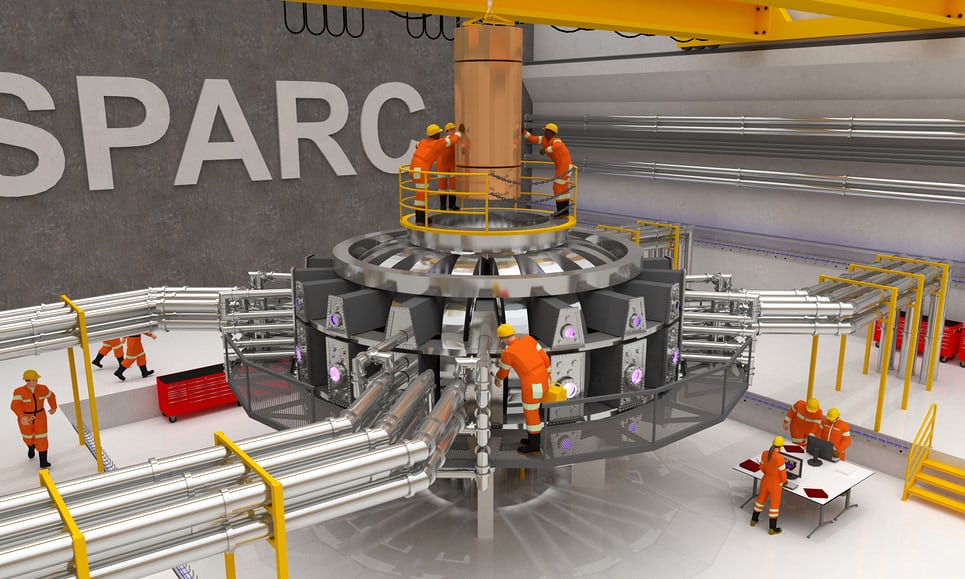MIT promises to launch a small thermonuclear power plant in 15 years

Visualization of the SPARC thermonuclear reactor. It has a capacity of 20% of ITER, and the size is 65 times smaller. Illustration: Ken Filar / MIT
Controlled thermonuclear fusion is a real holy grail for energy. If physicists learn to keep the plasma in a magnetic trap and spend less energy on the magnets than is released as a result of the reaction, then mankind will receive an almost inexhaustible source of clean energy, and fossil fuels from hydrocarbons and uranium can be forgotten as a terrible dream (especially since stocks for a long time is not enough).
Now mankind consumes 22,255 TWh of electrical energy annually (on average, 3052 kWh per person in the world, 6588 kWh in Russia, 12,833 kWh in the United States, 40 kWh per person in Haiti). Consumption grows every year, and fossil sources will end sooner or later (the same uranium-235 remains for about 50 years).
')
Therefore, it is already necessary to prepare for the end of the era of the use of fossil fuel types - and to consider alternative options. These can be torium reactors, plutonium fast neutron breeders, solar batteries (to meet the needs of humanity, it is enough to collect 0.5% of the solar energy falling on the Earth) and so on. But nuclear fusion is a cardinal solution to the problem, because it potentially represents an inexhaustible source of energy for the development of the Universe in general. Nuclear fusion will not only provide the current energy needs of mankind, but will provide much more energy. We have to think where to spend it.
Attempts to create a working fusion reactor were made repeatedly. Since 2007, the construction of the ITER (International Thermonuclear Experimental Reactor) has been underway, but the project has been significantly outdated by $ 5 billion, and the deadlines have been repeatedly postponed. There are other experiments with thermonuclear fusion , but so far real results are far. Now one more has joined them. Nuclear physicists from the Massachusetts Institute of Technology (MIT), together with the new company Commonwealth Fusion Systems, announced the start of a new experiment , in which they promise to build a working prototype of a fusion reactor in just 15 years, that is, by 2033. For work, Commonwealth Fusion Systems has raised $ 50 million in investment from Italian energy giant Eni.
Project manager is Bob Mumgaard, he is appointed executive director of a private company. “We strive to have a working power station [on thermonuclear fusion] in time to fight climate change. We think that we have the scientific knowledge, speed and scale to start delivering clean energy of thermonuclear fusion to the grid in 15 years, ”Mamgaard said . This is a very ambitious statement, experts say.
In the discussion of thermonuclear usually used to talk about the horizon in 30 years and more. But the MIT team believes it can cut the time in half by using new superconducting materials in the production of super-powered magnets. We are talking about superconducting material from a steel strip coated with yttrium-barium-copper oxide (YBCO, "and-be-ku"). After the discovery of this material in 1987, it became the first superconductor with a critical temperature greater than 77 K, which made industrial use of superconductors possible, because relatively cheap liquid nitrogen could be used to cool them for the first time.
YBCO allows you to design super power magnets much smaller than before. To begin with, MIT is going to manufacture a prototype 100 MW reactor of only 1/65 size from ITER in 10 years. It will produce energy in pulses of 10 seconds - heat is not planned to be converted into electricity, but scientists expect that the energy produced will be about twice as much as the cost of heating the plasma. In this case, the experiment is recognized as successful. Then, the construction of a 200 MW reactor will begin with a generator that supplies electricity to the network. If the project is completed successfully within the stated period of 15 years, then this may be the world's first actually working thermonuclear power station.
Thermonuclear reactor powered by hydrogen. Unlike uranium and hydrocarbons, it is almost an endless source of fuel.
Source: https://habr.com/ru/post/410767/
All Articles